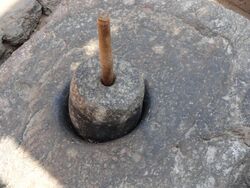Engineering:Wet grinder
A wet grinder can refer either to a tool for abrasive cutting of hard materials or to a food preparation appliance used especially in Indian cuisine for grinding food grains to produce a paste or batter. A wet grinder for abrasive cutting uses fluid for lubrication or cooling; for food preparation, a wet grinder combines water to grain as it is ground to produce a batter.
The tabletop wet grinder is derived from the melanger, which was developed by the chocolate industry in the early 19th century.[1]
Abrasive cutting wet grinders
Some angle grinders, most tile saws, and some grinders for sharpening blades used in woodworking are wet grinders. The fluid helps with lubrication of the cutting process and with cooling to avoid cracking or damaging the cutting tool or the workpiece.
Food preparation wet grinders

Wet grinding is rare in western cuisine but common in Indian cuisine.[2][3] Wet grinders are used to make pastes from grains and lentils and is used extensively in South Indian cuisine for preparation of popular dishes such as dosa, idly, vada, appam and paniyaram.[4][5][6][7][8][9] It consists of a granite stones which rotate inside a metal drum with the help of an electric motor and the food grains get crushed between the stone and drum.[10] Wet grinders have two advantages over electric mixers or blenders. First, the stone grinder generates less heat than a mixer; heat affects the flavor of the food. Second, the stones remain sharp for a greater time than do metal blades.
Types of wet grinders
Originally stones manually operated, modern wet grinders are available for both home usage and larger-scale commercial production. A wet grinder consists of granite stones rotating inside a metal drum with the help of an electric motor. Food grains are crushed between stones in the drum.[10] Modern wet grinders may use grinding stones that are circular or conical. Wet grinders have some advantages over electric mixers or blenders. A stone grinder generates less heat than a mixer, and heat can affect the flavor of the food. Unlike mixers, which cut food into smaller pieces, a wet grinder crushes the food, resulting in different consistency.
Geographical indication
In 2005, the Government of Tamil Nadu applied for Geographical Indication for Coimbatore wet grinder.[11] Wet grinders are largely manufactured in Coimbatore because granite is easily available in this region.[9] Beginning in March 2006, the label "Coimbatore Wet Grinder" is a registered geographical indication for Tamil Nadu.[12]
References
- ↑ Making Chocolate: From Bean to Bar to S'more: A Cookbook. Clarkson Potter/Ten Speed. 2017. pp. 84. ISBN 9780451495365. https://books.google.com/books?id=hw8cDgAAQBAJ. "Melangers typically have a smaller capacity than other industrial mills, so most large makers don't use them; Hershey did, but abandoned them in the 1950s for larger-capacity ball mills. This was about the same time that the electric motor reached India, where melangers were co-opted for making dosas (fermented rice-and-bean creps) because they produce less heat than other mills and preserve the living enzymes in dosa batter."
- ↑ Diagnostic study of the "wet grinder cluster" at Coimbatore (Report). Development Commissioner, Ministry of Micro, Small and Medium Enterprises. http://www.dcmsme.gov.in/schemes/wet_grinder_cluster.pdf. Retrieved 24 January 2016.
- ↑ Krishna Dubey (2010). The Indian Cuisine. PHI. pp. 29. ISBN 9788120341708. https://books.google.com/books?id=U4woRbF8irsC&q=what+is+wet+grinder+cuisine.
- ↑ Farnworth, Edward R. (2003). Handbook of Fermented Functional Foods. CRC Press. ISBN 978-0-8493-1372-1.
- ↑ Charmaine O' Brien (15 December 2013). The Penguin Food Guide to India. Penguin Books Limited. pp. 378. ISBN 978-93-5118-575-8. https://books.google.com/books?id=BGhBAgAAQBAJ&pg=PT378.
- ↑ K. T. Achaya (November 2003). The Story of Our Food. Universities Press. pp. 80, 90. ISBN 81-7371-293-X. https://books.google.com/books?id=bk9RHRCqZOkC&pg=PA80.
- ↑ P. Thankappan Nair (2004). South Indians in Kolkata. Punthi Pustak. p. 320. ISBN 81-86791-50-7. https://books.google.com/books?id=swNuAAAAMAAJ.
- ↑ Vir Sanghvi (1 January 2004). Rude Food: The Collected Food Writings of Vir Sanghvi. Penguin Books India. pp. 109–110. ISBN 978-0-14-303139-0. https://books.google.com/books?id=eK1uGVxmEiUC&pg=PA110.
- ↑ 9.0 9.1 Diagnostic study of the "wet grinder cluster" at Coimbatore (Report). Development Commissioner, Ministry of Micro, Small and Medium Enterprises. http://www.dcmsme.gov.in/schemes/wet_grinder_cluster.pdf. Retrieved January 4, 2014.
- ↑ 10.0 10.1 "How to choose a Wet grinder". indiacurry.com. http://www.indiacurry.com/faqappliance/wetgrinder.htm.
- ↑ "GI tag: TN trails Karnataka with 18 products". Times of India. 29 August 2013. http://timesofindia.indiatimes.com/city/chennai/GI-tag-TN-trails-Karnataka-with-18-products/articleshow/6458268.cms.
- ↑ "Registration Details of G.I Applications 2003 - 18 November 2013". Geographical Indications Registry (Intellectual Property Office, Chennai). http://ipindia.nic.in/girindia/treasures_protected/registered_GI_18November2013.pdf. Retrieved 28 December 2013.
 |




